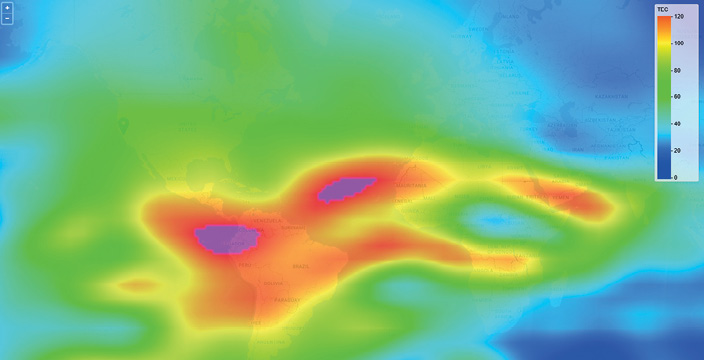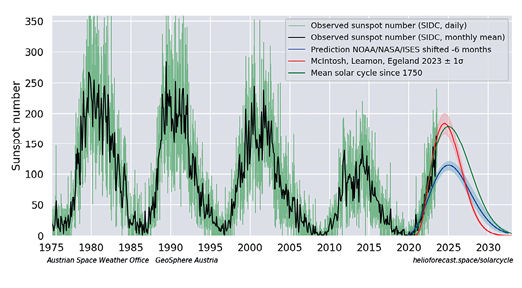Precision beyond the noise

Preparing for solar-triggered signal disruptions
Automated and autonomous operations are essential and expanding parts of mine operations worldwide. Technology is built into nearly every task — with a large majority dependent on global navigation satellite systems (GNSS) for precise positioning, safe navigation, and productivity gains. Mine sites include equipment that ranges from remote-controlled and robotic drilling machines to driverless haul trucks.
The Research and Market’s Global Mining Automation Market report recently noted that mining automation is on the rise, driven by technologies including robotics, machine learning and data analytics, which enable mining companies to automate processes, cut costs and improve safety. The report anticipates the global mining automation market size will grow from US$3.6 billion in 2024 to US$5.1 billion by 2029. And, nearly all these machines and workflows are reliant on accurate positioning delivered via GNSS satellites to hardware and software that processes these signals.
What happens when those GNSS signals go down, or perhaps even worse, deliver inaccurate data?
It is a very real challenge, particularly in high latitudes, such as in Canada, as the influences of Solar Cycle 25 grow. The current 11-year solar cycle began in 2019 and is anticipated to peak between 2024 and 2026, a time when ionospheric scintillation (signal noise) will be at its highest level — and GNSS signal reliability is at the most risk.
A measure of significance
Ionospheric scintillation is the rapid modification of radio waves in the ionosphere. It extends from about 80 to 966 km above earth’s surface. Severe scintillation conditions can prevent a GNSS receiver from locking on to the signal and make it very difficult to calculate a position.

By how much is dependent on several factors — though several metres of error are not uncommon. A 2014 study in Brazil evaluated the impact of scintillation on real-time kinematic (RTK) positioning using ionospheric scintillation data collected in the country during the solar maximum year 2014. The report noted significant positioning errors when dynamic RTK processing strategies were used during strong scintillation events. In this case, the study found the maximum positioning deviations in the east, north and upper directions reaching 2.29 metres, 1.84 metres, and 1.37 metres, respectively.
Similar GNSS position deviations have been noted during the past three solar cycle peaks dating back to the early 1990s by mining customers in Canada, particularly in northern regions like Alberta.
For mine operators who have invested in autonomous machines as well as remote-controlled and automated precision applications, scintillation is already a concern. As occurrences increase in frequency and severity as the solar maximum approaches, owners might see more downtime and shutdowns for mines that rely on precision GNSS applications. For instance, the level of positioning error noted above (e.g., 2.29 metres) can result in long-haul road truck accidents (with another truck or into a berm).
Perhaps the most challenging problem of scintillation is that loss of accuracy may not be immediately apparent. Autonomous vehicles could continue operating with inaccurate data, potentially leading them to wrong locations, causing productivity losses or even accidents. Automated systems are also at risk. For instance, GNSS position deviations could trigger false alarms or miss slope movement in slope stability monitored areas.

To make matters more challenging for owners and operators, the random and intermittent nature of scintillation events makes it difficult to predict and plan for this upcoming solar cycle peak. Scientists might estimate that ionospheric activity will occur at midday or dusk, for instance, but that will not always be the case. The disturbance can be random. As the solar cycle peak draws closer, the frequency will increase and the number of times where precision GNSS powered machines are not going to work predictably will rise.
The solar fix
Scintillation is not a new issue in the GNSS space, and leading manufacturers continue to improve receiver tracking and processing algorithms to minimize the disruption of signals during future cycles. Ionospheric mitigation features have been added and improved upon in GNSS receivers over the past three solar cycles, with frequency independence just one such adjustment. During ionospheric storms, there can be significant frequency-dependent differences in the phase and carrier delay through the ionosphere. Ensure your receivers are not dependent on any one frequency for operation.
To prepare for the current and future solar maximums, Trimble leveraged comprehensive data collection exercises to develop IonoGuard technology. This technology is designed to mitigate cycle slips and improve signal tracking of disrupted GNSS signals. It is an additional layer of protection that makes precise GNSS measurements possible under the most challenging atmospheric conditions, increasing the likelihood of uninterrupted and robust positioning data around the clock. During recent solar storm events in Brazil, Peru, and northern Sweden, the improvement in both horizontal and vertical positional accuracy using IonoGuard was significant. Bottom line, there are solutions available to minimize the risk of impact caused by scintillation in the coming years, but those strategies must be put in place in the near term.
One of the main challenges to resolving scintillation in mines is the lengthy validation process required for implementing new technology solutions — often taking six months or longer. While developing solutions to issues like GNSS signal losses, simply coming up with a hypothetical fix is not sufficient. That fix then needs to be thoroughly tested and validated to ensure it will work properly and safely without disrupting mine operations or other systems.
The intensive validation process for new technology involves testing in labs, with system integrators and on actual mine sites. The length of this validation means mines need to work with technology partners that already have identified problems and have solutions in place well in advance of when peak issues are set to occur.
Moving forward
There is no question that scintillation will directly affect the positioning accuracy of GNSS-enabled mine solutions in the future, but every owner can minimize those effects with the following steps to success:
> A mitigation strategy is essential, so be aware the peak season for GNSS issues in 2024 will be toward the end of the year, so strategies should be developed as an integral part of risk management plans and in place by then if not sooner.
> Work closely with a technology partner that has experience developing solutions to GNSS accuracy issues and can help validate and deploy solutions quickly before problems become critical. That technology partner should already have solutions that have been validated in real-world conditions. When evaluating solutions, consider automation that can detect errors in real-time and adapt accordingly to minimize downtime from accuracy losses and look for features like real-time ionospheric correction.
> Make sure to validate any new technology thoroughly by testing to avoid unintended disruptions, as validation takes significant time but is important for safety and productivity.
In equatorial and high latitude regions, like Canada, Brazil, and Chile, ionospheric disturbances are common, and will only intensify in the coming years. With Solar Cycle 25 on track to peak over the next two years, the time is now to implement a solution.
Kevin Andrews is director of land product at Trimble Applanix. Giri Baleri is director of product management and strategic marketing for Trimble OEM GNSS. Riley Smith is a marketing director for Trimble Geospatial.
Comments